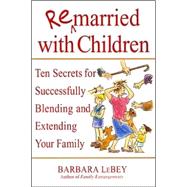
| Introduction: The Ten Secrets | 1 | (8) | |
| one The Obstacle Course | 9 | (31) | |
|
|||
| two The Ex Factor | 40 | (27) | |
|
|||
| three The Fade-Out Father | 67 | (26) | |
|
|||
| four The Wicked Stepmother: Fact or Fiction? | 93 | (30) | |
|
|||
| five Ex-In-Laws, and Other Extension Cords | 123 | (27) | |
|
|||
| six The Pleasure of Your Company... | 150 | (21) | |
|
|||
| seven Dollars and Sense | 171 | (32) | |
|
|||
| eight Sensitive Issues and Bad Influences | 203 | (29) | |
|
|||
| nine A Death in the (Blended) Family | 232 | (21) | |
|
|||
| ten Can We Talk? | 253 | (22) | |
|
|||
| Author's Note | 275 | (6) | |
| Bibliography | 281 | (4) | |
| Resources | 285 |
The New copy of this book will include any supplemental materials advertised. Please check the title of the book to determine if it should include any access cards, study guides, lab manuals, CDs, etc.
The Used, Rental and eBook copies of this book are not guaranteed to include any supplemental materials. Typically, only the book itself is included. This is true even if the title states it includes any access cards, study guides, lab manuals, CDs, etc.
Excerpted from Remarried with Children: Ten Secrets for Successfully Blending and Extending Your Family by Barbara LeBey
All rights reserved by the original copyright owners. Excerpts are provided for display purposes only and may not be reproduced, reprinted or distributed without the written permission of the publisher.